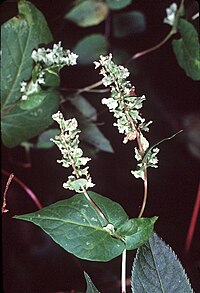| Fallopia scandens | |
|---|---|

| |
|
Scientific classification
| |
| Kingdom: | Plantae |
| Clade: | Tracheophytes |
| Clade: | Angiosperms |
| Clade: | Eudicots |
| Order: | Caryophyllales |
| Family: | Polygonaceae |
| Genus: | Fallopia |
| Species: | F. scandens
|
| Binomial name | |
| Fallopia scandens | |
| Synonyms [2] | |
| |
Fallopia scandens, the climbing false buckwheat, is a species of Fallopia native to North America. [1] It is a herbaceous perennial plant which grows from to 1–5 m (3–16 ft) tall. [1] Although they are semi-erect during bloom, when they are producing fruit, they hang from their pedicels in a downward position. Both the fruit and flower are greenish-white in appearance. [3] In North America, it is often misidentified with Fallopia dumetorum, a species endemic to Europe. [1]
References
- ^ a b c d "Fallopia scandens". Flora of North America. Retrieved 10 October 2015.
- ^ "Fallopia scandens (POLSD)". EPPO Global Database. Retrieved 10 October 2015.
- ^ "Fallopia scandens". Encyclopedia of Life. Retrieved 10 October 2015.
-
 Media related to
Fallopia scandens at Wikimedia Commons
Media related to
Fallopia scandens at Wikimedia Commons
| Fallopia scandens | |
|---|---|

| |
|
Scientific classification
| |
| Kingdom: | Plantae |
| Clade: | Tracheophytes |
| Clade: | Angiosperms |
| Clade: | Eudicots |
| Order: | Caryophyllales |
| Family: | Polygonaceae |
| Genus: | Fallopia |
| Species: | F. scandens
|
| Binomial name | |
| Fallopia scandens | |
| Synonyms [2] | |
| |
Fallopia scandens, the climbing false buckwheat, is a species of Fallopia native to North America. [1] It is a herbaceous perennial plant which grows from to 1–5 m (3–16 ft) tall. [1] Although they are semi-erect during bloom, when they are producing fruit, they hang from their pedicels in a downward position. Both the fruit and flower are greenish-white in appearance. [3] In North America, it is often misidentified with Fallopia dumetorum, a species endemic to Europe. [1]
References
- ^ a b c d "Fallopia scandens". Flora of North America. Retrieved 10 October 2015.
- ^ "Fallopia scandens (POLSD)". EPPO Global Database. Retrieved 10 October 2015.
- ^ "Fallopia scandens". Encyclopedia of Life. Retrieved 10 October 2015.
-
 Media related to
Fallopia scandens at Wikimedia Commons
Media related to
Fallopia scandens at Wikimedia Commons